.
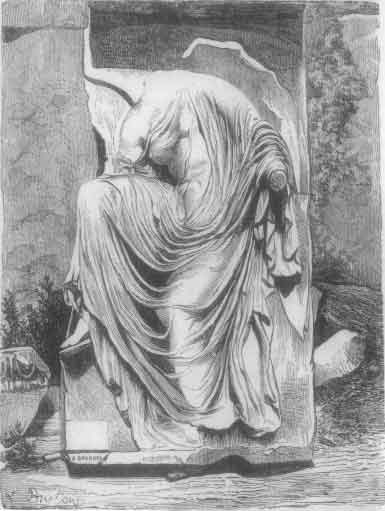
Nike Untying Her Sandals, Acropolis.
In Greek mythology, Nike (Greek Νικη, pronounced /'nike/ "Nee-keh", meaning "Victory") (Roman equivalent: Victoria), was a goddess who personified triumph and victory. She was capable of running and flying at great speeds. Nike was the daughter of Pallas and Styx and the sister of Cratos, Bia, and Zelus. Nike and her siblings were all companions of Zeus.

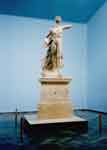
The Nike of Paionios victory column in Olympia and a variation in Germany, the Siegessäule of Berlin
Other than her great speed, she had no special powers of her own. She was effectively treated as a bringer of good luck and was often assimilated with other gods, for instance being depicted by Greek sculptors as a tiny winged figure perching on another god's arm, peeping out from a fellow god's clothes or flying above like a winged fairy. In her best-known depictions, such as the Winged Victory of Samothrace (now in the Louvre, Paris), she is shown as a naked or armoured winged figure. She was often depicted on Greek vases with her standard attributes of wreath, jug, phial, and thymiaterion (censer), shown standing alone, flying or striding, or pouring a libation over an altar. In some regions (particularly the Greek colonies of southern Italy) she was depicted as a charioteer. Elsewhere she was sometimes shown holding weapons or trophies, or playing a lyre or a flute.

The Nike of Samothrace landing on a war-ship
Nike was often worshipped in conjunction with Athena, with whom she was particularly closely associated after the Greek victory over the Persians at the Battle of Salamis in 480 BC. The great statue of Athena Parthenos in the Parthenon in Athens is thought to have depicted Nike, and the Parthenon complex included a Temple of Athena Nike, built around 410 BC. The Athenians also dedicated a statue to Nike at Delphi. The statue of Zeus at Olympia reportedly also depicted Nike. On occasions, Athena was depicted with Nike's attributes. According to Pausanias, the statue of Athena Nike depicted a wingless Nike ("Nike Apteros"), supposedly so that the statue could never leave the city of Athens. This temple has also provided a famous surviving depiction of the goddess, Nike unfastening her sandal ("Nike Slancio"), which was originally part of the temple parapret and is now on display in the Acropolis Museum in Athens.

Statuette of goddess Nike found in Vani, Georgia
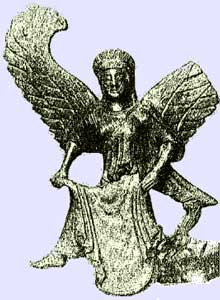
Archaic Nike from the Acropolis
Nike also presided over athletic as well as military contests. It was this meaning that prompted US footwear entrepreneur Phil Knight to borrow her name for his company, Nike, Inc., the clothing and sportswear manufacturer.
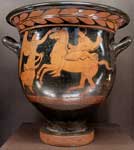
Krater, Louvre G493, Sisyphus Painter
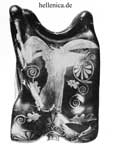
Nike, Syriskos, Rome Villa Giulia 866


Nike of the painter Hegias 275378, Kylix now lost


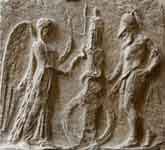
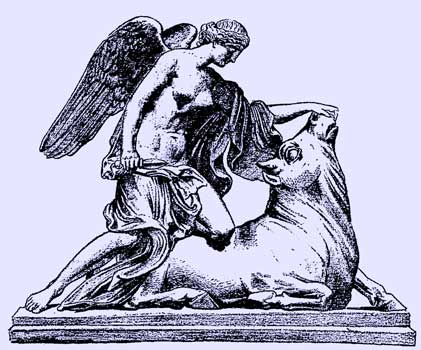
Nike with a bull, British Museum

Victory, Edoardo Rubino

Nike" monument Kos, Lefteris Valakas
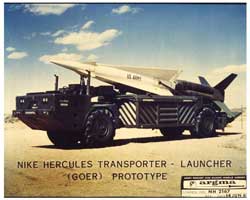
Nike-Hercules, an United States Army surface-to-air missile named after Hercules and Nike, used by the Greek army
In Christianity, the image of winged angels as messengers of spiritual victory owes a great deal to Nike.
See also : Greek Mythology. Paintings, Drawings
| Ancient Greece
Science, Technology , Medicine , Warfare, , Biographies , Life , Cities/Places/Maps , Arts , Literature , Philosophy ,Olympics, Mythology , History , Images Medieval Greece / Byzantine Empire Science, Technology, Arts, , Warfare , Literature, Biographies, Icons, History Modern Greece Cities, Islands, Regions, Fauna/Flora ,Biographies , History , Warfare, Science/Technology, Literature, Music , Arts , Film/Actors , Sport , Fashion --- |
Retrieved from "http://en.wikipedia.org"
All text is available under the terms of the GNU Free Documentation License

